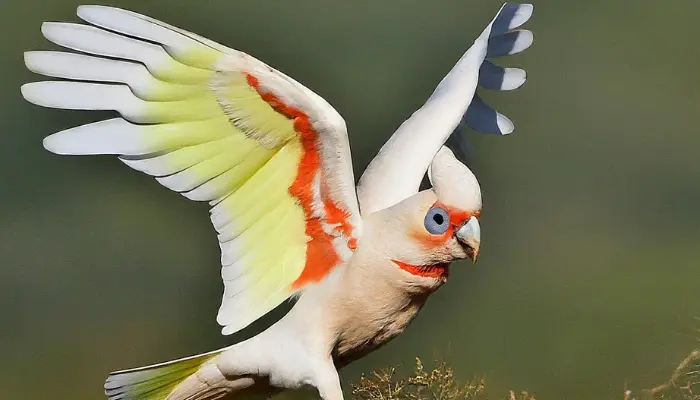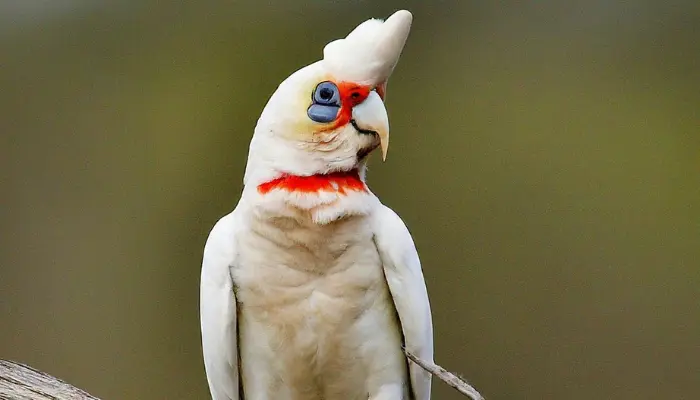Best Diet for Long-billed Corella Cockatoo
The best diet for a Long-billed Corella Cockatoo consists of a variety of nutritious foods that meet their specific dietary needs. Here is a breakdown of what their diet should include.
- Pellets: High-quality pellets formulated specifically for cockatoos should form the foundation of your Corella’s diet. Pellets provide essential nutrients and vitamins and help ensure a balanced diet.
- Fresh Fruits: Offer a variety of fresh fruits daily, such as apples, oranges, bananas, berries, and melons. These provide essential vitamins, minerals, and antioxidants. Make sure to remove any seeds or pits from fruits that can be toxic to birds.
- Fresh Vegetables: Include a variety of fresh vegetables in your Corella’s diet, such as leafy greens (kale, spinach, romaine lettuce), carrots, bell peppers, broccoli, and peas. Vegetables provide important vitamins, minerals, and fiber.
- Sprouted Seeds: Sprouted seeds are a nutritious addition to your Corella’s diet and provide enzymes, amino acids, and increased nutritional value compared to dry seeds. You can sprout seeds like mung beans, lentils, and alfalfa.
- Nuts: Offer nuts such as almonds, walnuts, and unsalted peanuts as occasional treats. Nuts are high in fat, so they should be given sparingly to avoid obesity.
- Legumes: Legumes like cooked beans and lentils can be included in your Corella’s diet for added protein and fiber. Ensure they are thoroughly cooked and free from seasonings or additives.
- Whole Grains: Whole grains like cooked brown rice, quinoa, and whole wheat pasta can provide additional nutrients and energy. Avoid refined grains and products with added sugars or salts.
- Calcium Sources: Provide calcium-rich foods such as cuttlebone, mineral blocks, or crushed eggshells to ensure your Corella maintains strong bones and beak health.
- Clean Water: Always ensure your Corella has access to fresh, clean water. Change the water daily to prevent contamination.
- Limit Treats: While treats like seeds, dried fruits, and occasional small amounts of human food can be given as treats, they should make up only a small portion of your Corella’s diet to prevent obesity and nutritional imbalances.
It is essential to offer a varied diet to meet your Corella’s nutritional needs and prevent boredom. Monitor their intake and adjust their diet as needed based on their activity level, age, and health status. Consulting with an avian veterinarian can also provide guidance on tailoring a diet specific to your bird’s needs.
Top 10 Interesting Facts About Long-billed Corella Cockatoo
The Long-billed Corella Cockatoo is a fascinating bird. Here are ten interesting facts about them.
- Long Bill: As the name suggests, Long-billed Corella Cockatoos have an impressive elongated bill that sets them apart from other cockatoos. This specialized bill helps them forage for food efficiently.
- Distinctive Appearance: They have a unique appearance with mostly white plumage and a flush of pink on their chests. Their eyes are dark and their bills are a contrasting pale color.
- Social Creatures: Long-billed Corellas are highly social birds and are often seen in large flocks. They form strong bonds with their flock mates and engage in various social activities like preening and playing.
- Vocal Communicators: Like many cockatoos, Long-billed Corellas are adept at vocalizing. They use a variety of calls to communicate with each other, including squawks, screeches, and whistles.
- Intelligent Birds: These birds are known for their intelligence and problem-solving skills. They can learn tricks and tasks quickly and enjoy mental stimulation.
- Destructive Behaviors: In captivity, Long-billed Corellas may exhibit destructive behaviors if not provided with enough mental and physical stimulation. This can include chewing on furniture and other objects.
- Feeding Habits: Long-billed Corellas primarily feed on seeds, nuts, fruits, and vegetation. They use their powerful bills to crack open nuts and seeds.
- Nesting Behavior: During the breeding season, Long-billed Corellas build their nests in tree hollows. They line the nests with leaves, twigs, and other materials.
- Threats and Conservation: Habitat loss, hunting, and capture for the pet trade pose significant threats to Long-billed Corella populations. Conservation efforts are underway to protect their natural habitats and raise awareness about their conservation needs.
- Cultural Significance: Long-billed Corellas hold cultural significance for some Indigenous Australian communities. They feature in traditional stories and art, highlighting the deep connection between Indigenous peoples and the natural world.
These facts offer just a glimpse into the fascinating world of the Long-billed Corella Cockatoo.

Where to Buy or Adopt a Long-billed Corella Cockatoo
If you are interested in buying or adopting a Long-billed Corella Cockatoo, there are a few options you can explore.
Avian Rescue Centers
Start by checking with avian rescue organizations in your area. They often have birds available for adoption, including Cockatoos. These centers usually provide a loving environment for birds that need new homes.
Breeders
Look for reputable breeders who specialize in Cockatoos. Make sure to do thorough research and choose a breeder who prioritizes the well-being of their birds and practices ethical breeding standards.
Online Classifieds
Websites such as Petfinder, Adopt-a-Pet, or even Craigslist may have listings for Long-billed Corella Cockatoos available for adoption. Exercise caution and thoroughly vet any potential sellers to ensure the bird’s health and welfare.
Some Pros and Cons to Keep Long-billed Corella Cockatoo as a Pet
Here are some pros and cons to consider when keeping a Long-billed Corella Cockatoo as a pet.
| Pros |
Cons |
| Intelligent and Social: Corellas are highly intelligent birds and can form strong bonds with their owners. They enjoy interactive play and can learn tricks and mimic sounds with proper training. |
Loud Vocalizations: Corellas are known for their loud vocalizations, which can be disruptive, especially in urban or apartment settings. They may scream, squawk, or mimic sounds at high volumes. |
| Beautiful Appearance: Long-billed Corellas are striking birds with their white plumage and vibrant pink markings on their face and throat. They make visually appealing pets. |
Destructive Behavior: Like many parrots, Corellas have strong beaks and a natural inclination to chew. Without appropriate outlets for this behavior, they may damage furniture, walls, and other household items. |
| Long Lifespan: With proper care, Long-billed Corellas can live for several decades, providing companionship for a significant portion of your life. |
Time-Consuming: Corellas require a significant amount of time and attention from their owners to prevent boredom and behavioral issues. They thrive on social interaction and mental stimulation. |
| Affectionate: Many Corellas enjoy cuddling and physical affection from their owners, forming strong emotional bonds. |
Specialized Diet: Long-billed Corellas require a varied diet consisting of pellets, fresh fruits, vegetables, and occasional treats. Providing a balanced diet can be both time-consuming and costly. |
| Entertaining: These birds are naturally curious and playful, providing endless entertainment with their antics and interactions. |
Potential Health Issues: Like all pets, Corellas are susceptible to various health problems, including respiratory infections, nutritional deficiencies, and behavioral issues stemming from stress or boredom. |
Before deciding to keep a Long-billed Corella Cockatoo as a pet, it is crucial to thoroughly research their care requirements and consider whether you can provide the time, space, and resources needed to meet their needs.
People Allso Asked




